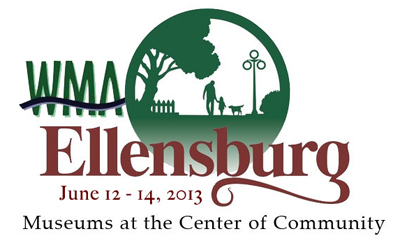By Eric Taylor
 Each June, the Washington Museum Association (WaMA) holds its annual conference at a different location around the state. Seeking to bridge the Cascade divide to encourage attendance from the entire Washington museum community, conference venues alternate year to year from westside to eastside. The 2013 Conference in Ellensburg took advantage of that city’s central location to attract attendees from both sides of the mountains.
Each June, the Washington Museum Association (WaMA) holds its annual conference at a different location around the state. Seeking to bridge the Cascade divide to encourage attendance from the entire Washington museum community, conference venues alternate year to year from westside to eastside. The 2013 Conference in Ellensburg took advantage of that city’s central location to attract attendees from both sides of the mountains.
Running from June 12-14, 2013, with the theme, “Museums at the Center of Community: Representative, Reflective, and Relevant,” this year’s conference continued the excellent programs and sessions that WaMA members have come to expect. Beginning with a half-day workshop on creating a workable membership plan, and optional tours of museums, historic sites, and natural settings around Kittitas County, the conference offered participatory engagement from its outset.
“Registrars to the Rescue,” established last year, and offered in conjunction with the WaMA Conference, recruits collections professionals, who volunteer their services in a daylong SWAT team approach to tackle an organization’s current collections challenges, while laying the groundwork for museum staff to continue the work afterward. This year, Ellensburg’s Clymer Museum & Gallery, chosen through a competitive process, took advantage of the hands-on help to assess the condition of its large art works and move them to a specially-designed, climate-controlled storage area. This new program, promoting mutual assistance among museum professionals, has rapidly become an essential part of the conference’s opening day.
Day two of the conference commenced at Central Washington University with the annual awards program, where WaMA honored outstanding exhibits, programs, institutions, volunteers, staff, and scholarship recipients. Keynote speaker, Jack Nisbet, author of David Douglas: A Naturalist at Work, cited the award winners as emblematic of those who have organized, preserved, and interpreted the cultural resources that he actively uses in his research. During a lunchtime plenary session, conference attendees were reminded of the importance of consistent museum advocacy at the local, state, and national levels, followed by breakout sessions that day and the next which focused on topics including interpretive programming, collections stewardship, cultural education, exhibit design, and interdisciplinary collaboration.
Although, the three-day conference provided a full schedule of relevant and informative content, numerous occasions arose for networking and plain fun through planned events and unstructured free time. Encouraging and facilitating active connections among attendees, while they experience the host site’s unique flavor, is a consistent goal of conference planners. In that regard, Ellensburg did not disappoint. Thanks to the Local Arrangements Committee, conference goers quickly immersed themselves in the community’s historic downtown culture through a progressive opening reception with different food and drink pairings at various galleries and museums.
The annual banquet, held the second evening on the site of the Ellensburg Rodeo, offered barbeque fare and acoustic musical entertainment with a bluegrass twist. Museum folks showed that they know how to cut a rug when they kicked up their heels to catchy country beats. Because of generous sponsors, attendees were provided ample refreshment breaks throughout the conference, which offered additional opportunities for greeting peers, meeting vendors, and bidding on silent auction items to benefit the scholarship fund.
For the Washington Museum Association, a nearly all-volunteer organization, implementing the annual conference is a major undertaking that requires active board involvement and numerous partnerships. However, through extensive planning and coordination, the pieces continually come together to create a highly worthwhile experience. With this year’s conference consigned to the memory books, plans are now well underway for the 2014 WaMA Conference in Port Townsend next June.
Eric Taylor is the Heritage Lead for 4Culture in Seattle, Washington He currently serves as president of the Washington Museum Association board, and actively participates with heritage groups nationally, regionally, and locally.








Comments
The Story of 25 Fossils X 25 Schools Ballroom D Panel: Diane Quinn, Burke Museum; Briana Nino, Burke Museum; Dr. Ruth Martin, Burke Museum Inspired collaborations are core to museum work and essential to our success. When the Burke Museum partnered with business leaders to answer an urgent need in the schools, the museum’s paleontology division became central to the project. This case study—from the original request, to building the pilot program, to involving funders in meaningful service projects—illustrates how all partners benefit when museums take the lead in serving Washington students.
Great review Eric!
Add new comment